What is a Mechanical Keyboard Key Switch?
When choosing a mechanical gaming keyboard you are usually offered multiple versions differing by a choice of included key switches. For example, the popular Corsair K95 RGB Platinum XT is available with either Cherry MX Speed Silver, Blue or Brown switches. Each key switch type has a slightly different feel when gaming. Some feel smooth and are quiet, others are more tactile and noisy (some very noisy!), and others offering a middle ground. Some keyboards even allow you to swap out the key switches, called a hot-swappable keyboard. For example, I use the Glorious GMMK Tenkeyless keyboard that includes the Gateron Brown key switches as standard; however, the keyboard has been designed to allow the key switches to be easily removed and swapped out. This allows you to upgrade the feel of your keyboard as your needs change, or you simply want something different without the expense of a new keyboard. A set of key switches is also relatively inexpensive (USD 30 to 40), which can effectively give you a completely different keyboard experience.
Choosing a pre-built keyboard, building a custom keyboard or choosing to upgrade the key switches of an existing hot-swappable keyboard requires you to decide on the type and feel of the key switch. If you are a gamer, specific styles of key switches are favoured over others.

I have included key switches that are compatible with the Cherry MX standard, making them suitable for most hot-swappable keyboards.
The Mechanical Key Switches Types
The primary reason for choosing a mechanical gaming keyboard is due to the use of a mechanical key switch rather than other switch technologies such as those on a membrane or scissor keyboard. Mechanical keyboards are very popular with gamers due to their smooth switches and high build quality. There is quite a lot of variation between the available key switches, but they all fall into 3 main categories.
- Linear - A linear key switch has a smooth and consistent feel throughout the keystroke. They are preferred by gamers but less so by typists who like to 'feel' the keypress more, resulting in faster typing speeds.
- Tactile - A tactile key switch has a tactile bump partway through the keystroke. For some switches, this is felt at the start of the key travel, for others it is felt further down. The bump signifies that the key has registered the press and that you do not need to continue to press the key. This is unlike a linear switch where you are not aware of the point the keypress is registered. Tactile key switches are favoured by typists as it means they do not have to fully depress the key resulting in faster typing speeds. Some switches, such as the tactile Gateron Brown, the bump is very soft and is hard to notice. Others, such as the Cherry MX or Kailh Brown have a more noticeable bump.
- Clicky - A clicky keyboard is one that you may first think about when you consider a mechanical keyboard. They closely resemble the typing experience of a typewriter, providing a stronger tactile bump as well as a loud click at the point the keypress is registered. This loud noise is also what makes a clicky mechanical keyboard less appealing to those in open or office environments.
The Best Key Switch Type for Gaming
When choosing a mechanical keyboard, gamers usually prefer a key switch that is both fast and smooth. This gives a fast in-game response time and the smooth key travel minimises any finger fatigue. A linear switch is therefore recommended for gaming.
A tactile switch is perfectly acceptable if you also do a lot of typing and like the feedback offered from a tactile switch. However, if you are predominantly gaming, then the feel of the tactile bump can be annoying over longer gaming sessions. Whilst the bump can be subtle, it can become noticeable over time.
A clicky switch is not recommended for gaming. You can feel the click and the noise from the clicks can interfere with online gaming and streaming, where the background noise of the keyboard can be heard on the recorded audio. I do find it interesting that several gaming keyboard manufacturers include the option of a clicky switch, such as Logitech with the Romer-G GL Clicky switches. I guess this is to ensure that all switch types are covered; however, most gamers I have spoken to do not like the background noise they generate, especially those who stream over Twitch or YouTube.

The Best Key Switches for Gamers
I have split the recommendations between the dedicated gamer and the more casual gamer.
The Dedicated Gamer
If you are a professional gamer or gaming is your primary use of your keyboard, then I recommend the Speed Silver style of key switches. They have a slightly reduced activation and travel compared to other linear switches and should (in theory) improve response and reaction times when gaming. In practice I find the difference too small to notice; however, if gaming is your passion (or profession), only the best will do, and the minutest of differences can make a difference.
Runner Up - Kailh Speed Silver - Very similar to the Cherry MX Speed Silver, with the Kailh being a slightly bit scratchier. However, this is a common complaint with the Kailh linear switches.
The Casual Gamer
If gaming is more of a hobby, then I recommend a more traditional linear key switch.
Runner Up - Gateron Red - The Gateron Red is included in several popular mechanical gaming keyboards, and for good reason. They have a buttery smooth feel whether you are gaming or typing.
Runner Up - Cherry MX Red - As you would expect from the original Cherry MX, the Reds have a nice smooth feel. I do slightly prefer the Gateron though, which seems to have an even smoother feel.
You can also opt for the Gateron Black if you prefer a slightly heavier feel to the key presses. I did find them slightly too heavy for long gaming or typing sessions, but many people do prefer the more solid feel.
I have not included any of the Kailh linear switches as I simply think their linear switches are not as good as either the Cherry MX or Gateron equivalents. They have a slightly scratchy feel that can be noticeable with faster typing or gaming. The clicky Kailh switches are very good, but their linear and tactile switches fall below those from Cherry or Gateron.
Anatomy of a Mechanical Key Switch
A mechanical key switch is made from only 5 parts. They are made from high precision plastic polymer with a gold-plated internal switch to ensure minimal wear and achieve a long lifespan. Many switches are rated to last between 50 million and 100 million key presses.
1) Upper Housing - The upper housing is made from a plastic polymer to a very high level of tolerance, guiding the stem to create a smooth vertical movement with a negligible wobble. You will notice that with very cheap keyboards, the keys feel very unstable when typing.
2) Stem - The stem is made of plastic polymer that creates vertical movement and the key feel. For a tactile or clicky key switch, the stem is responsible for the tactile or clicky characteristics due to its unique shape and design.
3) Crosspoint Contact - Usually gold-plated, the crosspoint contact is the heart of the key switch. Using gold ensures there is no corrosion throughout the life of the switch.
4) Coil Spring - The coil spring provides the resistance you feel when you depress the key. Each switch type uses a different rated spring. You can see the effect of the spring when looking at the activation force value for each switch.
5) Base Housing - Like the upper housing, the base housing is made from a plastic polymer. The base housing both holds together the switch internal mechanism and also forms the mount with which it connects to the keyboard base.
Key Switch Terminology
There are several terms used when comparing the specifications of a mechanical key switch.
- Activation Force - Measured in grams (g) and represents the force that needs to be applied to activate the switch. A lower number gives the keyboard a lighter feel; however, you may find that these switches are activated too easily. The higher the number the harder the keys will feel. A gamer or typist prefers a balance as too high an activation force can result in finger fatigue over time.
- Bottom Out Force - measured in grams (g) and represents the force that needs to be applied to fully bottom out the switch. Many switches have a similar activation and bottom-out force resulting in a smooth resistance throughout the keystroke. If the bottom-out force is higher than the activation force the switch will feel progressively harder to press throughout the keystroke.
- Activation - Measured in mm and represents the distance the key switch needs to travel before it is activated. Too little can result in keys being incorrectly activated if you are a fast touch typist and too high can make typing speeds slower as you need to depress each key further. Note that there is always a tolerance of around 0.6mm in these values. Some switches designed for gamers offered a reduced activation resulting in a faster response time.
- Travel - Measured in mm and represents the total travel of the key switch. Most mechanical key switches have travel of around 4mm, with some slim keyboards having reduced travel. Note that there is always a tolerance of around 0.6mm in these values. Some switches designed for gamers offered reduced travel resulting in a faster response time.
Key Switch IP Rating
Many key switches will offer an IP rating in their specifications for dust and moisture protection. For example, Cherry MX switches are rated at IP40 and Kailh at IP56. I have not been able to find any ratings specific to Gateron switches. You may see a similar rating for mobile phones and smartwatches, such as the iPhone that specifies a rating of IP68. So, what do these ratings mean?
IP stands for Ingress Protection, with the IP rating number being split into 2 digits, with the first digit representing the solid protection and the second digit the liquid protection.
- IP40 - This rating covers most Cherry MX switches, with a solid protection of 4, meaning protection against solid objects larger than 1 mm and a liquid protection of 0, meaning no rating or protection.
- IP56 - This rating covers most Kailh switches, with a solid rating of 5, meaning partial protection against dust and other particulates and a liquid protection of 6, meaning protection against powerful jets of directed water from any direction.
Even though this seems to show that Kailh is a clear winner, I would not personally read too much into this. If you do accidentally spill water onto your keyboard, I suspect the rest of the keyboard would not be that waterproof and also suffer damage. I have never had a key switch fail, but I did find it interesting to understand what these ratings mean.
Cherry MX
Cherry is based in Auerbach, Germany and has been manufacturing electrical and computer input devices since being formed in 1953 by Walter Cherry. They are responsible for the design of the original Cherry MX key switch first released in 1983. Ever since the Cherry patents for the MX switch design expired in 2014 several alternative manufacturers have entered the market with similar (and in many cases identical) designs. There were several features of the original patents, such as the self-cleaning mechanism that helped differentiate them from other styles of key switches and helped it become a world-leading key switch design. Cherry state that they have sold over 6 billion key switches and feature in more than 60 million keyboards worldwide.
Cherry MX switches are still engineering and manufactured in Germany.
The Cherry MX Red, Black and Speed Silver are all rated for 100 million activations and are IP40 rated for dust and moisture resistance.
Cherry MX switches come in either a standard MX or an MX RGB design that is optimised for use with SMD LEDs. All images show the MX RGB variant.
| Key Switch | Activation Force | Activation | Travel |
|---|---|---|---|
| Cherry MX Red | 45g | 2mm | 4mm |
| Cherry MX Black | 60g | 2mm | 4mm |
| Cherry MX Silent Red | 45g | 2mm | 4mm |
| Cherry MX Speed Silver | 45g | 1.4mm | 3.4mm |
Cherry MX Red
Often referred to as the original mechanical key switch, the Cherry MX Red is the most popular Cherry MX switch. It features a quiet mechanism, a smooth feel and a medium activation force of 45g.
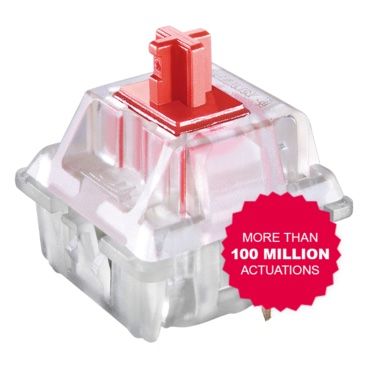
- Activation Force - 45g
- Activation - 2mm
- Travel - 4mm
Cherry MX Black
The Cherry MX Black requires more force to activate than the Red, 60g over 45g. Recommended if you prefer a more substantial key feel, but I do find that it can cause finger fatigue after longer gaming or typing sessions.
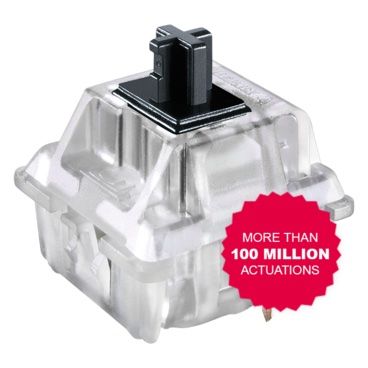
- Activation Force - 60g
- Activation - 2mm
- Travel - 4mm
Cherry MX Silent Red
To reduce the noise generated by the switch even further, the Silent Red includes a rubber dampener that reduces the noise when the mechanism bottoms-out, similar to adding o-rings to the keycap to reduce travel and dampen the sound. By including the dampener, the activation and travel are slightly reduced.
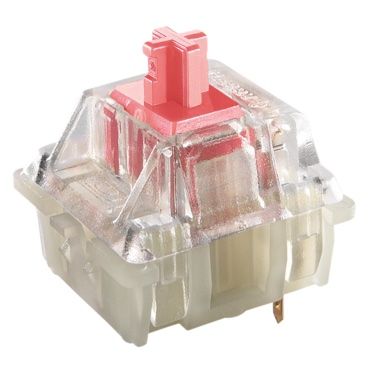
- Activation Force - 45g
- Activation - 1.9mm
- Travel - 3.7mm
The Cherry MX Silent Red is rated for 50 million activations, half that of the Red, Black or Speed Silver.
Cherry MX Speed Silver
The Cherry MX Speed Silver is very similar to the Cherry MX Red with a 45g activation force, but with less travel and activation to improve response times. The Speed Silver has been designed specifically for gaming, where a faster response time can improve gameplay.
- Activation Force - 45g
- Activation - 1.2mm
- Travel - 3.4mm
Gateron
Ever since Cherry's patents on the MX switches expired in 2014, the market has been flooded with inexpensive clones of their key switches. Many of these are of poor quality; however, a few companies such as Gateron and Kailh have grown to offer switches that match and in many cases better the Cherry equivalents.
Gateron is a Chinese manufacturing company that is located in Guangdong and has been manufacturing electrical key switches since 2000. They specialise in the development and production of electronic and electrical switches, sensors, and plastic hardware parts.
Gateron Key Switches
Most clone key switches are named and coloured according to their corresponding Cherry MX counterpart. Whilst they are designed from the original Cherry patents and imitate the Cherry MX switch feel, they are not always identical to their Cherry counterparts. Gateron is well known for producing a smoother switch than Cherry MX, especially their linear switches.
Gateron key switches are available with either solid or clear cases. The clear cases are popular if you use an RGB keyboard where the LED lighting shines through the key switches due to the RGB lights being mounted underneath the key switches. A solid key switch blocks a lot of the light.
| Key Switch | Activation Force | Activation | Travel |
|---|---|---|---|
| Gateron Clear | 35g | 2mm | 4mm |
| Gateron Red | 45g | 2mm | 4mm |
| Gateron Yellow | 50g | 2mm | 4mm |
| Gateron Black | 60g | 2mm | 4mm |
The quality of Gateron key switches is very high, and have a typical minimum of 50 million switch activations. I have not had a Gateron switch fail, and I have been using Gateron switches for several years.
Gateron Clear
The Gateron Clear key switch has a very light and soft feel with only a 35g activation force. However, you may feel that these are too light for gaming and you tend to bottom them out that can cause finger fatigue.

- Activation Force - 35g
- Activation - 2mm
- Travel - 4mm
Gateron Red
The Gateron Red key switch is the most popular Gateron switch for gaming. It offers a very smooth feel with a medium level of activation force at 45g.
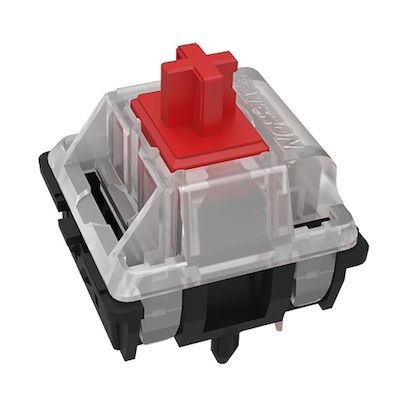
- Activation Force - 45g
- Activation - 2mm
- Travel - 4mm
Gateron Yellow
The Gateron Yellow is a slightly heavier version of the red (50g versus 45g activation force). The yellows are preferred over the black or reds due to their buttery smooth feel; however, they can be hard to find. They are my preferred linear key switch.
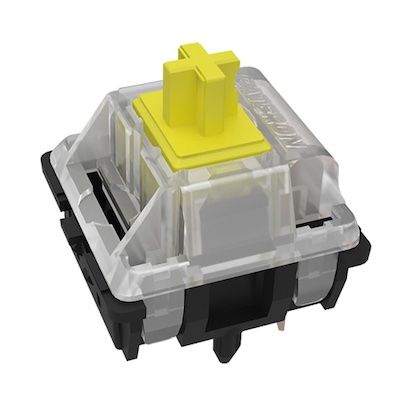
- Activation Force - 50g
- Activation - 2mm
- Travel - 4mm
Gateron Black
The Gateron Black is a slightly heavier version of the red. Similar in feel to the Cherry MX Black, the higher activation force can cause finger fatigue after long gaming or typing sessions.
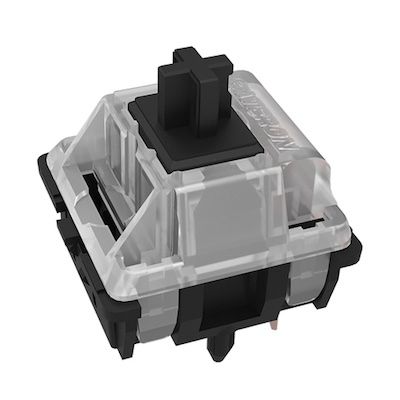
- Activation Force - 60g
- Activation - 2mm
- Travel - 4mm
Kailh
Kailh, or officially Dongguan Kaihua Electronics was founded in 1990. They specialise in electronic and electric switches. Whilst Kailh do manufacture clones of the original Cherry MX design, they have also developed several unique designs themselves, such as with their BOX design.
Kailh Key Switches
Even though Kailh has developed several different key switch designs, I find that Kailh falls behind Cherry and Gateron for linear and tactile switches, with only their clicky switches offering a solid alternative.
| Key Switch | Activation Force | Activation | Travel |
|---|---|---|---|
| Kailh Red | 50g | 2mm | 4mm |
| Kailh Black | 60g | 2mm | 4mm |
| Kailh Box Red | 45g | 1.8mm | 3.6mm |
| Kailh Box Black | 60g | 1.8mm | 3.6mm |
| Kailh Box Silent Red | 35g | 1.8mm | 3.6mm |
| Kailh Speed Silver | 50g | 1.1mm | 3.5mm |
Kailh Red
The Kailh Red is not as good as either the Cherry MX or Gateron with a slightly scratchy feel. The Kailh Box Red is a smoother switch.
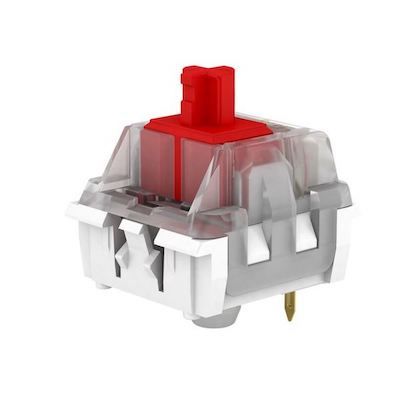
- Activation Force - 50g
- Activation Force - 65g
- Activation - 2mm
- Travel - 4mm
Kailh Black
The Kailh Black is not as good as either the Cherry MX or Gateron with a slightly scratchy feel. The Kailh Box Black is a smoother switch.
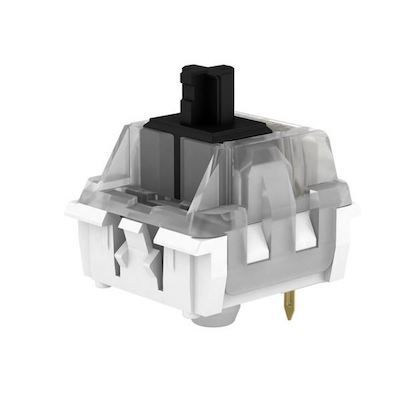
- Activation Force - 60g
- Activation Force - 70g
- Activation - 2mm
- Travel - 4mm
Kailh Box Key Switches
These switches feature a unique box design to the stem. The design keeps the stem protected to provide an IP56 rating for dust and moisture. The box design of the stem also reduces any keycap wobble.
Note that the Kailh Box switches are only compatible with SMD LEDs rather than the through-hole LEDs due to the IP56 water-resistant construction. They have slightly less travel (3.6mm) and activation (1.8mm) than standard switches.
All Kailh Box switches feature a 70 million actuation lifetime.
Kailh Box Red
I find the Kailh Box Red to be more scratchy than Cherry MX or Gateron Red.
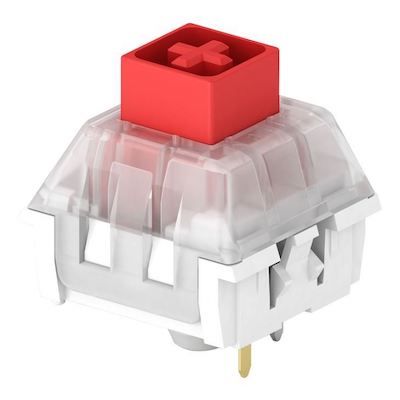
- Activation Force - 45g
- Activation Force - 60g
- Activation - 1.8mm
- Travel - 3.6mm
Kailh Box Black
I find the Kailh Box Black to be more scratchy than Cherry MX or Gateron Black.
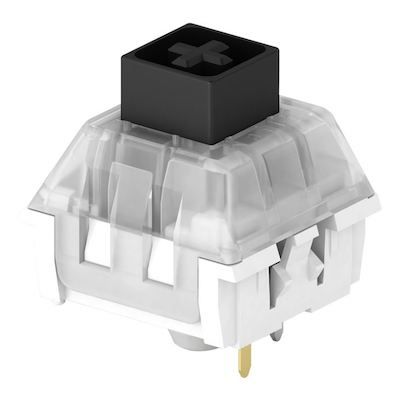
- Activation Force - 60g
- Activation Force - 70g
- Activation - 1.8mm
- Travel - 3.6mm
Kailh Box Silent Red
Similar in design to the Cherry MX Silent Red, the switch includes a rubber dampener to reduce noise when they bottom out. Unlike other Box designs, the stem features a circle shape rather than a box. Interesting the stem is a bright pink colour rather than simply a lighter red on the Cherry MX. The design does increase the activations to 80 million.
- Activation Force - 35g
- Activation Force - 45g
- Activation - 1.8mm
- Travel - 3.6mm
Overall, the Kailh Box Silent Red is not as smooth as the other Kailh Box designs, with the Red or Speed Silver offering a smoother feel with a similar activation force.
Kailh Speed Key Switches
Similar to the Cherry MX Speed switches, these are designed for gamers with reduced activation and travel distance.
Kailh Speed Silver
The Kailh Speed Silver has a smoother feel than the Kailh Box switches and the reduced activation and travel result in faster in-game response times. The activation force is also slightly higher than the Cherry MX, being 50g compared to 45g. I did not notice that this was too light, but I have found 35g switches (such as the Gateron Clear) to be far too light for gaming or typing. However, this does depend upon how hard you press the keys and if you lift off early or bottom out the keys.

- Activation Force - 50g
- Bottom Out Force - 55g
- Activation - 1.1mm
- Travel - 3.5mm
Conclusion
Being able to choose between key switches is a great advantage of choosing a mechanical keyboard or building your custom keyboard. There is a variety of switches available that are either aimed at or are better for gamers and gaming.
I always recommend trying out key switches where possible as it can be quite hard to decide upon your preferred switch from just a subjective set of technical data.
Key Switches Samples
To help you decide, I recommend getting an inexpensive key switch sample set that includes several switches to test. There are a number available on eBay, but my favourite is the Glorious Switch Sample Pack which contains 14 of the most popular switches from Gateron and Kailh.
- Gateron Switches - Black, Blue, Brown, Clear, Green, and Red
- Kailh Switches - Box Black, Box Brown, Box Red, Box White, Speed Bronze, Speed Copper, Speed Silver, and Pro Purple
- Glorious O-Rings - both thin and thick are included
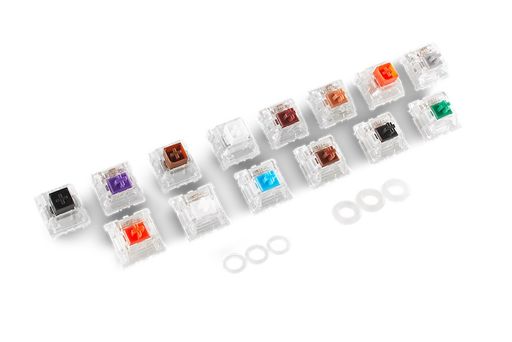
The included O-Rings can be added to key switches to dampen the feel and sound when the switch bottoms out when fully depressed. These can be popular if you are on conference calls or streaming, and you want to reduce the ambient noise, but still retain the feel of the key switch.
